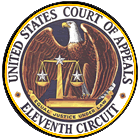Top Qs
Timeline
Chat
Perspective
United States Court of Appeals for the Eleventh Circuit
Current United States federal appellate court From Wikipedia, the free encyclopedia
Remove ads
The United States Court of Appeals for the Eleventh Circuit (in case citations, 11th Cir.) is a federal appellate court over the following U.S. district courts:
- Middle District of Alabama
- Northern District of Alabama
- Southern District of Alabama
- Middle District of Florida
- Northern District of Florida
- Southern District of Florida
- Middle District of Georgia
- Northern District of Georgia
- Southern District of Georgia
These districts were originally part of the Fifth Circuit, but were split off to form the Eleventh Circuit on October 1, 1981.[1] For this reason, Fifth Circuit decisions from before this split are considered binding precedent in the Eleventh Circuit.[2][3]
The court is based at the Elbert P. Tuttle U.S. Court of Appeals Building in Atlanta, Georgia. The building is named for Elbert Tuttle, who served as Chief Judge of the Fifth Circuit in the 1960s and was known for issuing decisions which advanced the civil rights of African-Americans.
The Eleventh Circuit is one of the 13 United States courts of appeals.
Remove ads
Current composition of the court
Summarize
Perspective
As of January 2, 2025[update]:
Remove ads
List of former judges
Remove ads
Chief judges
Chief judges have administrative responsibilities with respect to their circuits, and preside over any panel on which they serve, unless the circuit justice (the Supreme Court justice responsible for the circuit) is also on the panel. Unlike the Supreme Court, where one justice is specifically nominated to be chief, the office of chief judge rotates among the circuit judges.
To be chief, a judge must have been in active service on the court for at least one year, be under the age of 65, and have not previously served as chief judge. A vacancy is filled by the judge highest in seniority among the group of qualified judges, with seniority determined first by commission date, then by age. The chief judge serves for a term of seven years, or until age 70, whichever occurs first. If no judge qualifies to be chief, the youngest judge over the age of 65 who has served on the court for at least one year shall act as chief until another judge qualifies. If no judge has served on the court for more than a year, the most senior judge shall act as chief. Judges can forfeit or resign their chief judgeship or acting chief judgeship while retaining their active status as a circuit judge.[4]
When the office was created in 1948, the chief judge was the longest-serving judge who had not elected to retire, on what has since 1958 been known as senior status, or declined to serve as chief judge. After August 6, 1959, judges could not become or remain chief after turning 70 years old. The current rules have been in operation since October 1, 1982.[5]
Succession of seats
Summarize
Perspective
The court has twelve seats for active judges, numbered in the order in which they were initially filled. Judges who assume senior status enter a kind of retirement in which they remain on the bench but vacate their seats, thus allowing the U.S. President to appoint new judges to fill their seats.
Remove ads
See also
- Courts of Georgia
- Judicial appointment history for United States federal courts § Eleventh Circuit
- List of current United States circuit judges
- List of United States federal courthouses in the Eleventh Circuit
- List of United States federal courthouses in Alabama
- List of United States federal courthouses in Florida
- List of United States federal courthouses in Georgia
Notes
- Recess appointment; formally nominated on April 9, 2003, given a recess appointment on February 20, 2004, confirmed by the United States Senate on June 9, 2005, and received commission on June 10, 2005
- Reassigned from the 5th Circuit.
References
External links
Wikiwand - on
Seamless Wikipedia browsing. On steroids.
Remove ads


